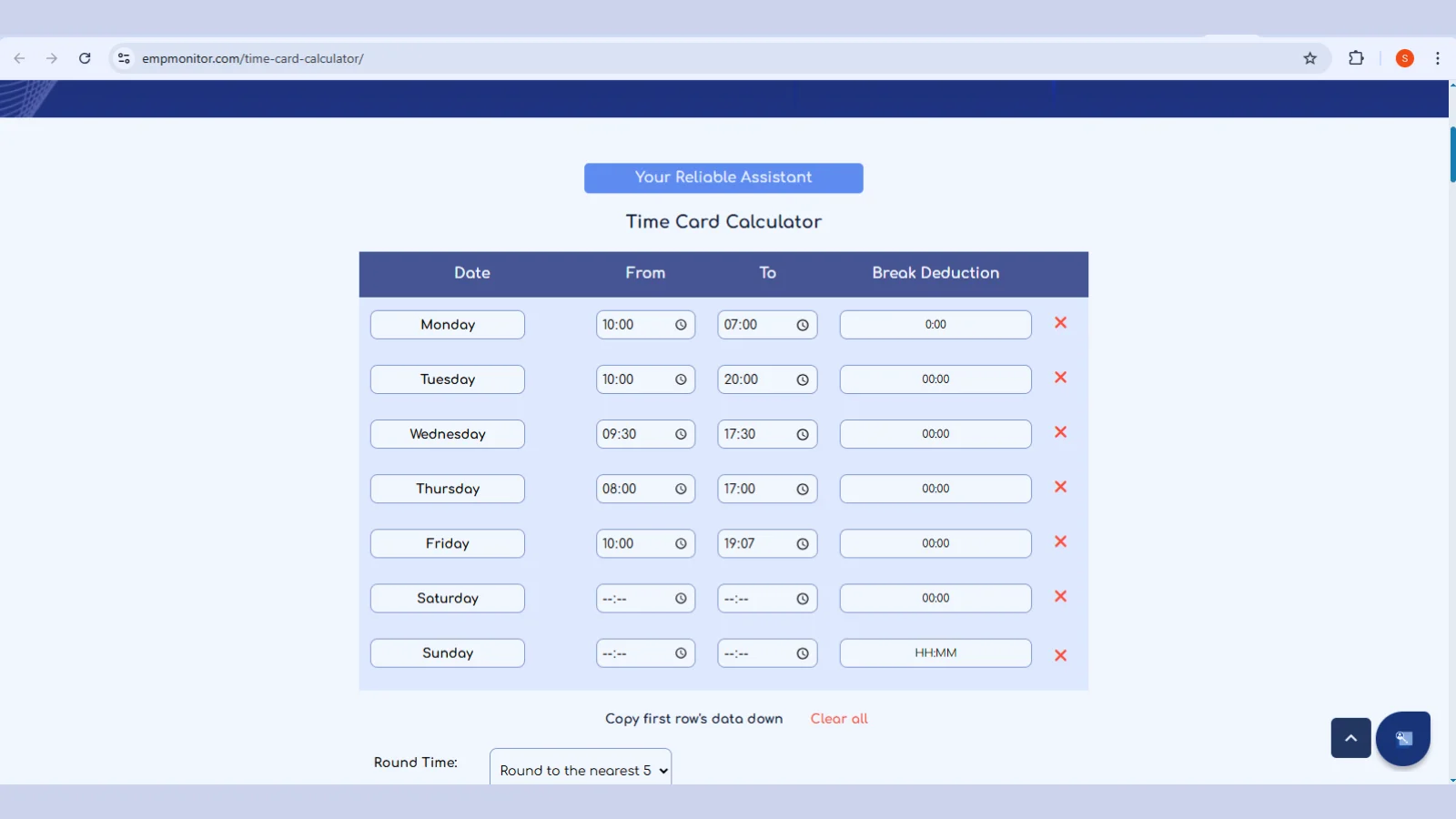A regular 9-to-5 schedule is evolving, and with it comes the increased relevance of understanding and leading over time. Because of this, overtime calculators have become a new gateway for employers.
The concept of overtime is more than just a means of financial compensation; it reflects the evolving nature of work and the need for fair remuneration. Understanding overtime rules is essential for everyone, regardless of whether you’re paid hourly, work freelance, or own a business. It helps ensure fair pay and a good balance between work and life.
The preciseness of the overtime pay calculator is not only a matter of financial importance but also a means to foster transparency and compliance with labor regulations.
As we delve into this comprehensive guide, we will explore the fundamentals of overtime, the benefits of using an effective overtime calculator, and provide practical insights into maximizing your earnings while preserving your well-being.
In a hurry? Listen to the blog instead!
What Is Overtime?
Overtime refers to the hours an employee works beyond their regular working hours, typically exceeding 40 hours per week in many jurisdictions.
These extra hours often come with a higher pay rate and encourage employees to take on additional tasks or extend their working hours when needed. After-hours can be voluntary or mandatory, depending on the employer’s policies and industry standards.
Laws & Regulations With Overtime
Understanding the legal aspects of overtime is essential for employees and employers to ensure compliance, fair treatment, and effective use of time calculators to manage employees.
Below are three crucial laws and regulations related to overtime:
Fair Labor Standards Act (FLSA) – United States
The FLSA establishes minimum wage, overtime pay eligibility, recordkeeping, and child labor standards for private and public sector employees. In the U.S., non-exempt employees are entitled to overtime pay at a rate of 1.5 times their regular hourly wage for hours worked beyond 40 in a workweek.
European Working Time Directive (EWTD) – European Union
The EWTD sets minimum requirements for working hours, including overtime provisions. In the European Union, the Working Time Directive states that the average workweek, including overtime, should not exceed 48 hours. Member states may have additional regulations, and the directive emphasizes the importance of rest periods.
Labour Standards Act – Canada
In Canada, the Labour Standards Act varies by province or territory. It outlines rules for regular and overtime hours and the corresponding pay rates. Most jurisdictions require employers to pay employees at least 1.5 times their regular rate for overtime hours.
What Are The Methods To Use Overtime Calculator?
When employees work beyond the standard working hours, overtime calculation methods are crucial to determining their extra pay.
Here are two methods to calculate overtime pay. The first method is known as “time and a half”, and the second method is called “double time”. With a proper overtime management plan in hand, employers can easily keep a tab on how much employees are over-working.
Time and a Half Method
Definition: The time-and-a-half method involves paying employees at a rate of 1.5 times their regular hourly wage for each hour worked beyond the standard 40 hours per week.
Example-
Regular Hourly Wage: $20
Overtime Hours Worked: 10hr
Calculation-
Overtime Pay Rate: $20 * 1.5 = $30 per hour (time and a half)
Overtime Earnings: $30 * 10 hours = $300
Key Points-
- This method is the most common and mandated by labor laws in many jurisdictions.
- The time-and-a-half method encourages employees to take on additional hours by offering a higher pay rate.
Double Time Method
Definition: The double-time method works as an overtime calculator. It involves paying employees at a rate of twice their regular hourly wage for each hour worked beyond a certain threshold, often exceeding 12 hours in a day or a specific number of hours per week.
Example-
Regular Hourly Wage: $25
Double Time Trigger: After 12 hours in a day
Calculation-
Overtime Pay Rate: $25 * 2 = $50 per hour (double time)
Overtime Hours Worked: 14
Calculation for Double Time Hours-
First 12 hours: $25 * 12 hours = $300
Next 2 hours (double time): $50 * 2 hours = $100
Total Overtime Earnings
$300 (time and a half) + $100 (double time) = $400
Key Points
- The double-time method applies when employees work exceptionally long hours, specifically beyond 12 hours in a day.
- It provides extra pay to acknowledge the added stress or inconvenience of long work periods.
Understanding these time calculation methods is vital for employers and employees to ensure fair compensation and adherence to legal standards. Such methods help organizations to understand how the employee time calculator works. Consult with local labor authorities or legal experts to stay up-to-date with specific regulations in your area.
Features of a Practical Overtime Calculator
A practical overtime or additional hour calculator should go beyond basic calculations, offering features that simplify the process for users. Over here are some key features to look for:
User-Friendly Interface
A good extra hours calculator should have an intuitive and user-friendly interface, making it accessible to employees and employers. The input fields should be clear, and the calculator should guide users through the process with minimal effort.
Customization Options
Flexibility is crucial when it comes to calculating overtime. The calculator should allow users to input various scenarios, including different pay rates for overtime, specific thresholds for double time, and any additional factors relevant to their situation.
Integration with Payroll Systems
For businesses, integrating the extra hour calculator with existing payroll systems streamlines the process and minimizes errors. Automation can significantly reduce the administrative burden, ensuring accurate and timely payments.
How To Automate Overtime Calculator?
In the digital age, automation plays a prominent role in simplifying complex tasks, including overtime calculations. One such notable tool in this domain is EmpMonitor, which offers an automated and efficient solution for tracking and calculating employee work hours.
EmpMonitor- Workforce Management Software
EmpMonitor is a robust workforce management tool that offers comprehensive insights into employee performance and engagement levels within an organization. It is a powerful software dedicated to optimizing productivity, streamlining workflows, and enhancing the overall performance of companies.
With its user-friendly interface and a suite of robust functionalities, EmpMonitor stands out as a valuable asset for organizations aiming to foster a more efficient and engaged overtime calculator for the workforce. The software helps businesses manage their workforce effectively by providing deeper insights into employee activities.
Time Tracking
This time tracking software enables real-time tracking of employees’ working hours. The tool accurately captures clock-in and clock-out times to ensure precise and reliable attendance records. EmpMonitor ensures that all hours worked are accounted for in the calculation process.
Reporting and Analytics
EmpMonitor offers detailed reports related to employee working hours and overtime. These insights are valuable for overtime calculators to maintain accuracy. It is also valuable for employees and employers, aiding in better workforce management.
Productivity Analysis
EmpMonitor goes beyond simple time tracking by offering insights into employee productivity. It provides data on how employees spend their time during working hours such as idle time, active hours and, productive hours. Such features allows employers to identify areas of improvement or recognize high-performing individuals.
Real-Time Tracking
EmpMonitor is a tool that allows employers to keep track of their employee’s working hours in real-time. It accurately records clock-in and clock-out times to ensure proper timekeeping. It ensures that all hours worked are accounted for in the calculation process, offering a comprehensive view of employees’ daily activities.
Screen Monitoring
For businesses concerned about productivity, EmpMonitor includes screen monitoring features. Employers can see what employees are working on in real time, fostering accountability and discouraging non-work-related activities during working hours.
Tracks Overtime
The platform automatically tracks overtime based on predefined rules or customizable settings. This feature plays a crucial role for employers and managers to calculate overtime of employees fairly.
How To Calculate Overtime With EmpMonitor?
Here is how EmpMonitor calculates overtime-
Step-1: Enter the details of your employees as shown in the below image-
Step-2: After adding the details, set the metrics as per your company rules and policies and click on calculate.
Step-3: Here is the final result. You can also download the report if you want.
Application and Website Usage Monitoring
EmpMonitor tracks the applications and websites employees use during work hours. Its features provide insights into how time is spent on different tasks, helping employers identify potential distractions or areas for improvement.
By automating the work tracking process with tools like EmpMonitor, organizations can enhance efficiency, reduce administrative overhead, and ensure accurate and compliant payroll practices.
Read More
Benefits Of Time Card Calculator For Your Business In 2023
How Does An Employee Time Calculator Work?
How Time Calculator Helps You Managing Employees In 2022?
Benefits of Utilizing an Overtime Calculator
The following are the advantages of having a time clock calculator.
Accurate Pay Estimation
A practical extra hours calculator ensures that employees receive accurate compensation for their overtime hours. The accuracy builds trust between employers and employees, fostering a positive working relationship.
Time Management and Work-Life Balance
For employees, an extra work calculator serves as a valuable tool for managing their time effectively. It allows them to balance their work commitments with personal and family responsibilities, promoting a healthier work-life balance.
Legal Compliance and Avoiding Disputes
Extra hours calculators that comply with labor laws can prevent employers from being sued for underpayment or miscalculation of overtime. The proactive approach reduces the risk of disputes and fosters a compliant work environment.
Make the Most Out of Overtime Calculator
Embracing a practical overtime or extra hours calculator goes beyond mere number crunching – it’s about empowering workers and businesses to navigate the complexities of overtime with confidence. The legal landscape surrounding overtime may differ across regions, but the fundamental principles remain the same: fair compensation for additional work hours.
Automation tools like EmpMonitor exemplify the potential of technology in simplifying overtime calculations. The robust features of the software aids employers in managing the workforce efficiently.
By understanding the laws, adopting modern calculation methods, and leveraging automation tools, employers and employees can contribute to a workplace where time is valued and compensation is fair. So, let’s embrace the power of practical overtime calculators and journey into a future where every hour worked is accurately recognized and duly rewarded.


















